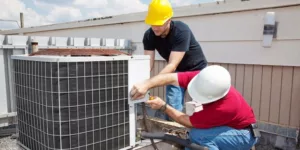there are “one sentence” paragraphs
Winter is coming, and it’s time to start thinking about your heating bills. Rising energy costs are going to hit consumers during the cold months – they always do. But technology is helping consumers save money on their heating and cooling bills.
A checkup of your HVAC system is recommended.
What this will do is ensure that your system is operating properly. HVAC systems last 15 – 20 years on average. If a system is 10 years old or older, it’s not as efficient as new models or even as efficient as when the unit was first purchased.
Internal components may need to be repaired, or the system may be working harder to heat the home.
Professionals will make repairs and maintain a unit in an effort to avoid major repairs in the future.
Filter replacements are also necessary. You can handle most replacements on your own, but a dirty filter can add an extra 15% to your electricity bills. If you’ve maintained your system, it’s time to turn to technology to help you start saving more money on your winter’s heating bills.
1. Smart Thermostats Are a Must-Have
Smart thermostats are a must-have if you want to start saving money on your HVAC system. A connected world has led to the rise of smart thermostats that may be able to connect to your home’s Wi-Fi system, depending on the model that you choose.
What’s great about these systems is that they’ll learn the habits of the homeowners.
If the homeowner increases the temperature every night on the thermostat, the system may learn this behavior and start making adjustments automatically.
And you may or may not have access to the system via an app or online portal.
When you’re away from home, you can connect to the system and make adjustments without ever stepping foot inside the home. These systems will be able to save as much as 10% – 12% on heating costs.
Cooling savings are a little higher.
There are also newer models that can detect when a person is in the home and make adjustments as necessary. If no one is home, the system may lower the heat setting to help you further save on energy costs.
Adjustments are made on your average usage.
When you choose a smart thermostat, these systems will make your home’s temperature more comfortable while saving you money.
2. Dual Fuel Heat Pumps
Dual fuel heat pumps, despite the name, are able to offer powerful heating and cooling. These heat pumps use gas and electricity fuels.
This doesn’t seem like it would be that much of a benefit on the outside, but dual fuels allow the unit to run on the most cost-effective fuel at the time of operation. With most setups, this means that electricity will be used to cool the home and natural gas will heat the home.
Natural gas prices are generally lower, and gas tends to provide more efficient heat in the colder months than electric or other fuel sources. Highly efficient as a fuel source, gas will make the interior of the home feel “dry,” and this will lead to dry skin and other problems.
But when the temperatures dip below 30s or in the low 30s, heat strips will kick in, which will be heated by electric. This is done to supplement the heat pump.
In most cases, dual fuel technology will save the homeowner money in the winter months.
3. Motorized Shades and Blinds
Motorized shades and blinds might not seem like a way to save on energy costs, but they’re highly efficient. These shades, which do come with an upfront investment of under $200 in most cases, can be controlled by timers or apps.
These timers can close the shades or open them.
Why is this important?
You can choose to have the motorized units open up on sunny days, allowing you to naturally heat your home. If you forget to open the blinds or shades, the tap of a screen may be able to open them.
In the summer, the unit can block the sun out, allowing your home to stay cooler.
Every model is different. Some operate via a remote, while others operate through apps.
If installed alongside insulated cellular shades, you’ll be able to reduce heat loss by a minimum of 40% – often higher.








